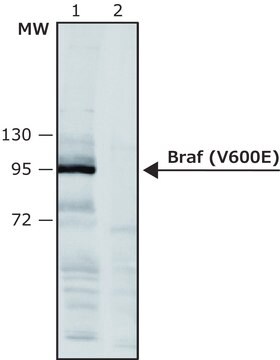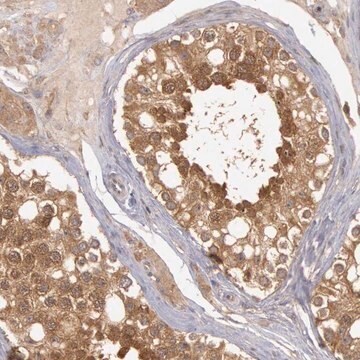推荐产品
重組細胞
expressed in HEK 293 cells
品質等級
抗體表格
purified immunoglobulin
抗體產品種類
primary antibodies
無性繁殖
RM8, monoclonal
recombinant monoclonal
形狀
buffered aqueous glycerol solution
物種活性
human
濃度
~1 mg/mL
技術
ELISA: 0.5-2 μg/mL
immunoblotting: 0.5-2 μg/mL
immunocytochemistry: 0.5-5 μg/mL
immunohistochemistry: 0.5-5 μg/mL
同型
IgG
NCBI登錄號
UniProt登錄號
運輸包裝
wet ice
儲存溫度
−20°C
目標翻譯後修改
unmodified
基因資訊
human ... BRAF(673)
一般說明
BRAF(B-Raf 原癌基因)是一种丝氨酸-苏氨酸激酶,编码 B-Raf 蛋白。它位于人类染色体7q34上。
特異性
该抗体与BRAF V600E突变体反应。与野生型BRAF无交叉反应。
免疫原
对应于BRAF V600E突变体的肽
生化/生理作用
BRAF(B-Raf 原癌基因)参与细胞生长的直接信号传导。它通过在皮肤黑色素瘤、甲状腺癌和结肠癌等各种肿瘤中启动丝裂原活化蛋白激酶 (MAPK) 途径,诱导肿瘤生长。
特點和優勢
请完全放心地评估我们的抗体。如果抗体在您的研究中无效,我们将全额退款或换货。了解更多。
外觀
溶于含有50%甘油、1%BSA和0.09%叠氮化钠的磷酸盐缓冲盐水中。
免責聲明
除非我们的产品目录或产品附带的其他公司文档另有说明,否则我们的产品仅供研究使用,不得用于任何其他目的,包括但不限于未经授权的商业用途、体外诊断用途、离体或体内治疗用途或任何类型的消费或应用于人类或动物。
未找到合适的产品?
试试我们的产品选型工具.
儲存類別代碼
10 - Combustible liquids
水污染物質分類(WGK)
WGK 2
閃點(°F)
Not applicable
閃點(°C)
Not applicable
The significance of BRAF V600E mutation status discordance between primary cutaneous melanoma and brain metastases: The implications for BRAF inhibitor therapy.
Hannan EJ, et al.
Medicine, 96(48), e8404-e8404 (2017)
Clinical significance of BRAF non-V600E mutations on the therapeutic effects of anti-EGFR monoclonal antibody treatment in patients with pretreated metastatic colorectal cancer: the Biomarker Research for anti-EGFR monoclonal Antibodies by Comprehensive Cancer genomics (BREAC) study.
Shinozaki E, et al.
British Journal of Cancer, 117(10), 1450-1450 (2017)
Eli E Bar et al.
Journal of neuropathology and experimental neurology, 67(9), 878-887 (2008-08-22)
Relatively little is known about the molecular changes that promote the formation or growth of pilocytic astrocytomas. We investigated genomic alterations in 25 pilocytic astrocytomas, including 5 supratentorial and 20 posterior fossa tumors, using oligonucleotide array comparative genomic hybridization. Large
Jaskaren Kohli et al.
Nature communications, 13(1), 7923-7923 (2022-12-24)
Human melanocytic nevi (moles) result from a brief period of clonal expansion of melanocytes. As a cellular defensive mechanism against oncogene-induced hyperplasia, nevus-resident melanocytes enter a senescent state of stable cell cycle arrest. Senescent melanocytes can persist for months in
我们的科学家团队拥有各种研究领域经验,包括生命科学、材料科学、化学合成、色谱、分析及许多其他领域.
联系技术服务部门








